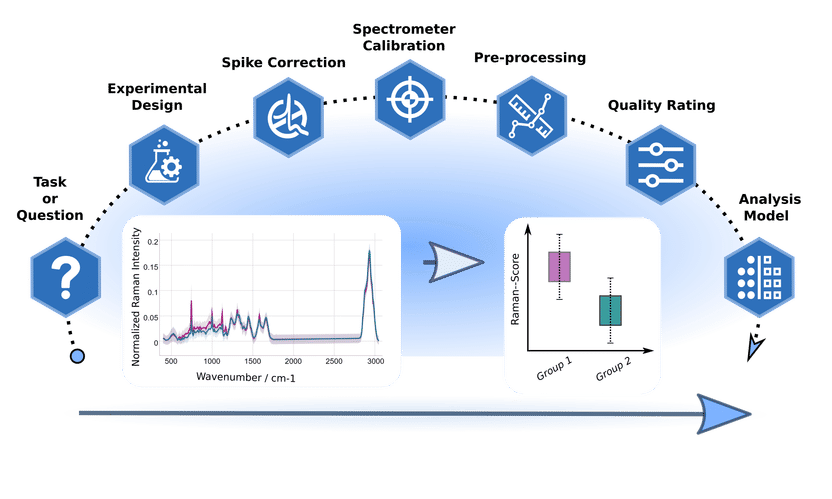Artificial intelligence for better diagnostics
Standardized methods facilitate the evaluation of Raman spectra
Advertisement
Light-based methods are increasingly used for analytical problems in the fields of health, environment, medicine and safety. Raman spectroscopy is a suitable method in this context. The measurement data collected in this process are complex and extensive molecular fingerprints. artificial intelligence can help in the analysis of these complex Raman spectra. There are still no established standards for the analysis, which makes it difficult to apply in medical or biological settings. A team of researchers from the Leibniz Institute for Photonic Technologies (Leibniz IPHT) and Friedrich Schiller University in Jena, Germany, have developed a guide for Raman spectral analysis.

Instructions for standardized Raman spectral analysis
Thomas Bocklitz, Leibniz-IPHT
Raman spectroscopy can be used to determine the molecular fingerprint of samples. This allows, for example, to distinguish materials based on their specific chemical composition. It is also possible to identify pathogens or detect diseased tissue. The signals to be detected and signal differences within the measurement data are minimal and are influenced by numerous factors. Machine learning - artificial intelligence (AI) - methods are used for the evaluation. "In order to help Raman spectroscopy achieve a breakthrough in applications, standardized workflows are needed that deliver results that are as robust as possible," says private lecturer Dr. Thomas Bocklitz, head of the Photonic Data Science research department at Leibniz IPHT as well as University of Jena. So far, however, there are no established unified standards for the analysis process of Raman spectra.
In a paper recently published in Nature Protocols, Bocklitz and colleagues for the first time provide guidance for the analysis of Raman spectra, covering all steps from experimental design and data preparation to data modeling and statistical analysis, while also pointing out potential pitfalls and how to avoid them. In doing so, the physical chemist was able to draw on his many years of experience in developing and refining data-driven methods. In the meantime, his team has become one of the leading international research groups working on the computer-aided evaluation of Raman spectra at the conceptual level. The close cooperation with the research department Spectroscopy/Imaging at Leibniz IPHT headed by Prof. Jürgen Popp has proven to be an advantage by contributing their expertise in the field of Raman spectroscopy for analysis and diagnostics in the fields of medicine, life and environmental sciences, quality and process analytics, and pharmaceuticals to the joint project.
The researchers from Jena want to contribute to standardized Raman spectral analysis with the published guidance. Together with partners from other research institutions, the next step will be to focus the methodology on instrument intercomparability through a joint ring trial by exploring methods to correct for instrument dependence. Finally, scientists at Leibniz IPHT and the University of Jena plan to use the standardized methods for AI-based evaluation of Raman spectra to develop market-ready light-based diagnostic methods and novel therapeutic approaches at the future Leibniz Center for Photonics in Infection Research in Jena.
Original publication
Other news from the department science
Most read news
More news from our other portals
See the theme worlds for related content
Topic World Spectroscopy
Investigation with spectroscopy gives us unique insights into the composition and structure of materials. From UV-Vis spectroscopy to infrared and Raman spectroscopy to fluorescence and atomic absorption spectroscopy, spectroscopy offers us a wide range of analytical techniques to precisely characterize substances. Immerse yourself in the fascinating world of spectroscopy!

Topic World Spectroscopy
Investigation with spectroscopy gives us unique insights into the composition and structure of materials. From UV-Vis spectroscopy to infrared and Raman spectroscopy to fluorescence and atomic absorption spectroscopy, spectroscopy offers us a wide range of analytical techniques to precisely characterize substances. Immerse yourself in the fascinating world of spectroscopy!




























































